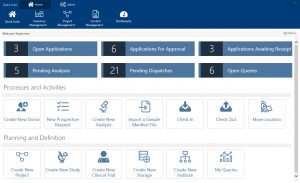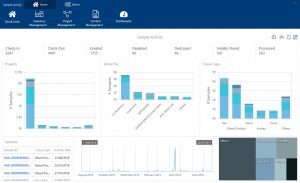Historically scientific software has been difficult to navigate and use. Biobanking software and Laboratory Information Management Systems (LIMS) are no exception. There seems to have been a common misconception that any software handling complex lab processes must also be complicated. For many years researchers and lab managers have struggled to get to grips with unwieldy systems. But now the tide is turning and there’s a new wave of LIMS focused on usability as well as those offering quick and easy deployment. So, what does ‘focusing LIMS and Biobanking systems on usability’ actually mean? And are these new systems as good as the ‘traditional’ ones?
What do we mean by LIMS ‘usability’?
The meaning of ‘usability’ varies depending on the product and goals of the user. However, put simply when it comes to software the system should be intuitive and easy for the user to learn, become familiar with and complete their objectives.
It’s not about design which can be very subjective. Although product design does have a significant impact on usability.
The simplicity of pre-configured workflows and systems
Traditionally, it can take many months, if not years to implement a LIMS or Biobanking system. In fact, for some being live in 2 years sounds like a quick implementation. What’s more, upgrading the software can take just as long – and cost just as much!
Some software providers offer systems that come prebuilt with critical lab workflows. In addition, some are now also offering pre-configured systems for specific industries such as pharmaceuticals, Biobanks and veterinary.

Having these prebuilt systems means it should be easier for you to work through the system and its processes. Training should also be simpler and deployment times should be greatly reduced. In general, with pre-configured LIMS and Biobanking software usability should be significantly improved.
This all sounds great but before you jump in make sure you can configure these processes and the wider system to meet your exact requirements. You don’t want to get stuck with a system that has some inbuilt processes that don’t remotely relate to how you work. Just as bad could be a process that, on the face of it, looks like it matches your requirements but doesn’t in some small but significant way. That’s easy to miss and can cause problems.
Also, just because the processes and the system are prebuilt it doesn’t mean they’re simple or easy to follow.
Configurable LIMS and Biobanking systems like Achiever Medical offer you the ‘best-of-both-worlds’ – prebuilt processes that you can configure and extend.
Functional and configurable web-based and cloud LIMS
 You only have to go back a couple of years and the thought of putting critical scientific and clinical research data in the cloud was unthinkable.
You only have to go back a couple of years and the thought of putting critical scientific and clinical research data in the cloud was unthinkable.
Many smaller labs have been using web-based sample tracking software for some time. These systems offer basic sample management functionality and some lab freezer storage management. They do what they do, and they do it well. By their nature, these cloud-based sample tracking systems have simpler user interfaces that are easy to use and navigate.
However, if you’re looking for something more advanced that you can also configure then this is where it becomes more challenging.
But there are web-based and cloud systems available like Achiever Medical that offer the depth and range of functionality available in more traditional client-server LIMS. These modern laboratory information systems offer core functionality that includes handling your lab processes, managing patient consent, meeting regulatory compliance, integrating with instruments and, importantly, protecting your personal identifiable information (PII). Plus, they’re configurable so you can map your lab workflows or change them to meet existing or new requirements. They’re quicker and easier to deploy due to their underlying infrastructure.
Web-based doesn’t necessarily mean simple
Many people use and are familiar with online systems. But just because systems are web-based doesn’t mean they’re well-designed or easy to use. The technology is certainly an enabler, but LIMS development also has to focus on creating an intuitive and easy to use system. And keeping things simple can be difficult!
There’s a new generation of LIMS, including Achiever Medical, that aims to be easier to use. The latest version of Achiever Medical includes a simpler user interface including a Quick Links Home Page. The laboratory information management system’s usability is at the forefront of our development efforts and we’re continuing to look into ways to improve your experience. The next version will build on lab feedback and include even more improvements in this area.
A user-friendly LIMS doesn’t mean there’s no training required
Just because something’s been designed with usability in mind it doesn’t mean you don’t need any training. Even everyday products like Microsoft Word and Excel require you to have some degree of knowledge to use them. You might have gained this from a colleague or online help system.
Likewise, with LIMS and Biobank management software you’ll always require an element of training or familiarisation. However, this shouldn’t take more than a few days.
A configured LIMS live in 3 months – pull the other one!
Getting you up and running with a system quickly can be achieved. We know as we’ve done it several times.
Having a prebuilt system that can quickly be configured to suit your requirements is a great start. It’s also about approach. We focus on knowledge transfer and deliver in-depth training, so you understand what’s already available in the system. As a result, you spend your time – and money – only on the areas that you need to change.
We also start you thinking about your data from day one.
In addition, using browser and cloud-based technologies can help not only in terms of speed of deployment but also from a design perspective. As more and more people are now online, when thoughtfully designed, these systems can feel familiar and therefore, more welcoming to users.
One important point to note, implementation success is as much about what you do as what the LIMS provider and the software does. We can give you a pre-configured system in days. We can also give you a configured system that does what you need in just a couple of months. But if you want to import your legacy data then you’ll need to clean it then this can cause delays.
The trick is to be prepared and know exactly what you want to achieve. If you don’t know what you want, then no software is going to be able to give you what you need in any amount of time.
Ways in which Achiever Medical LIMS simplifies usability

Achiever Medical Sample Activity Dashboard
When it comes to usability and simplifying the user experience Achiever Medical delivers:
- an easy to learn and memorable system
- an intuitive, easy to navigate interface
- an optimised ‘number of clicks’ to complete tasks
- useful data management tools such as data validation, auditing and formatting
- workflows and prompts to guide users through processes
- automated workflows and data entry where possible
- information at a glance, such as through dashboards
Achiever Medical delivers usable, intuitive software including core functionality that helps you ‘Make Every Sample Matter’.
Related topics
- ‘Make Every Sample Matter’ – How LIMS helps increase the chances of using samples in research
- Data Management in Laboratory Information Management Systems

Comments are closed.